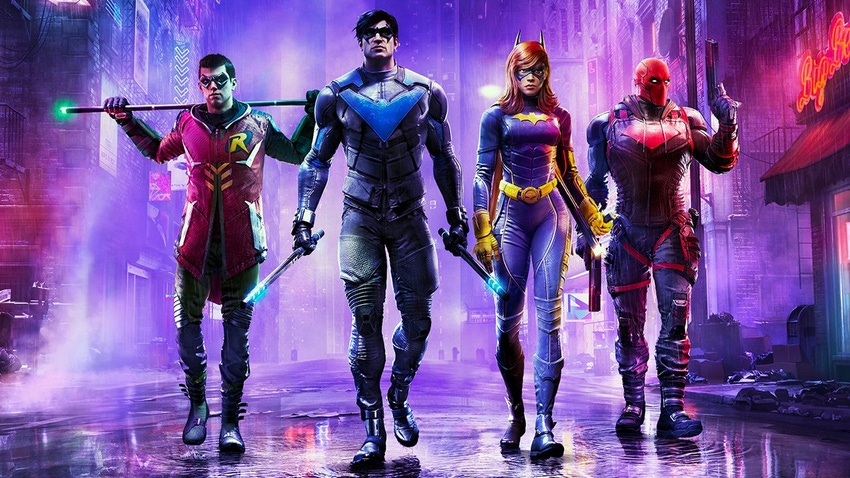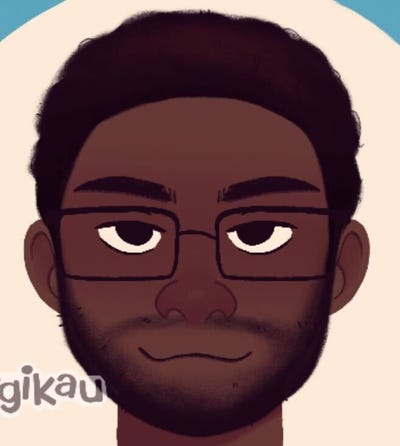.png?width=700&auto=webp&quality=80&disable=upscale)
How WB Montreal made Gotham Knights' cutscenes work for four playable heroes
WB Montreal's Wilson Mui discussed how Gotham Knights' cutscenes were made with its four heroes in mind, while ensuring they maintained their own individuality.

In Warner Bros. Montreal’s Gotham Knights, DC characters Nightwing, Robin, Batgirl, and Red Hood are the leads of the whole game. Across the game, the quartet of Batman disciples are placed in equal prominence in its story, which is a marked departure from the more recent Batman titles.
Since players can choose between the four characters to do any mission, its story has to accommodate for this fact, both in terms of gameplay and its narrative presentation. At 2023’s Game Developer’s Conference, WB Montreal’s cinematics directors Wilson Mui talked about the techniques and challenges that came with realizing the game’s core concept, and how that was reflected across the game’s two types of stories.
Mui explained that WB Montreal realized during pre-production that it had to manage content efficiently without also sacrificing quality or content scope. He and the game’s narrative director Ann Lemay agreed on a collaborative process with the writing team for all of the game’s cinematics. “It was important that our group was on the same page in terms of tone, gameplay, and narrative needs,” he said. “Translating the work into a visual scene with the writers helped us iterate on the best possible script for our storyboards and actors to work with.”

Gotham Knights’ heroes presented some technical challenges
Part of the cinematic process involved working towards capturing "the perfect take," which he described as the “best technical, audio, and artistic performance, including body and facial data.” Shooting those perfect takes with each of the four leads lightened the load for film management and outsourcing needs. But before those particular takes took place, Mui brought up how the cinematics team would do an “ugly but functional” first pass to identify what was missing or not working entirely.
For those interested in statistics, Mui revealed that Gotham Knights features 6 hours of cinematics (made up of 139 total), with 1.5 of those hours set in the Belfry (the players' home base). 74 of the cinematics were done as QUADS (the team's name for cinematics shot in a "4 in 1" style), and the all-time record to do a single scene was 27 takes. While he didn’t specify which cutscene had that many takes, he said it all when he just called it “a long day.”
As Mui described it, Gotham Knights has two types of cinematics: the mission cinematics (as it pertains to the game’s plot and villains), and cinematics in the Knights’ Belfry where their more personal stories take place. Speaking to the latter, Mui talked about how those scenes allowed the cinematics team to explore “the vulnerable superhero.” He brought up a particular cutscene involving Barbara Gordon and Tim Drake that featured tight camera angles to convey how Tim was encroaching on her personal space, and said other cutscenes employ similar filmmaking tactics. “I wanted to create a sense of claustrophobia between Tim and Barbara, keeping the action tight-quartered and uncomfortable to create visual tension and conflict.”
In regards to the mission cinematics and the briefings more specifically, he said that the approach was to “love all your children equally.” Meaning that the four heroes (and also Alfred) were filmed and written with equal importance in a scene. Performance-wise, it was important to make each of them an active participant in some capacity. The team also worked to ensure their personalities came across, even when they were in the background. “Always assume the player was watching their character only and not the others in the scene,” he advised.
Of the two, he admitted that the mission cinematics were the most complex to make. Because the Knights are all different people with their own personalities, cutscenes had to be shot with as QUADS to deliver the same information, but in slightly different ways. The rigging and movement of the characters had to be factored in as well, since Red Hood is physically bigger than Robin, who moves differently from Nightwing, and so on. Even the 64 costumes spread across the heroes functioned as variables when all was said and done.

Those aforementioned master takes (especially the audio beats) were more “critical” here, since all four versions had to fit the QUAD template. Even something as small as a requested dialogue change could go on to affect facial animations, lighting, and so on. WB Montreal’s solution was to make a master scene of rough animatics featuring a particular character (all four were used in equal measure, according to Mui) that would then be used as a guideline for the other three in terms of timing and camera cuts. In some cases, cutscenes were allowed to have different timing, camera placements, and more to ensure they had their own unique energy with a specific hero.
As an example, Mui played four scenes at once showing each of the Knights meeting Harley Quinn for the first time in the game. There's some differences dependent on each hero; Harley jokes about Red Hood previously dying, will banter about "girl time" with Batgirl, and ogles Nightwing's buttocks (fans of Nightwing have historically done the same). There are other cutscenes in the game that have similar differences that players have noted since the game's release last year.
After Mui’s presentation, I asked him about the Gotham Knights cinematics and how they were developed over time. He revealed that when he was brought on, it wasn’t fully clear how either the Belfry or QUAD scenes would be handled in-game, and they required “a lot of exploration” on his part. “We made a benchmark scene out of [a Harley] scene to validate that we could the 4-in-1 technically, mentally, and as a team. We nailed something pretty cool,” he said.
When playing the game in co-op, the second player will appear in a cutscene towards the end. That itself took a lot of work, and when asked about how that would’ve worked with four-player co-op, he called it “impossible” and said it would’ve been a lot of work with even more factors than the game as is.
“We did the math, there’s no way I can deliver that. [...] It can’t exist.”
Read more about:
FeaturesAbout the Author(s)
You May Also Like












